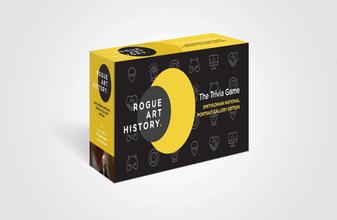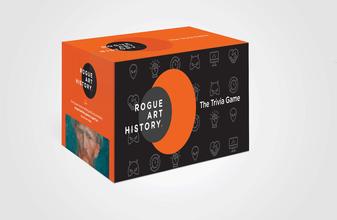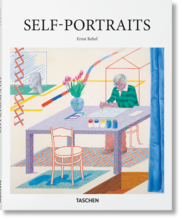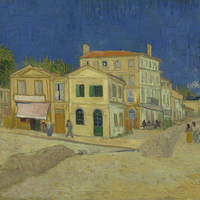More about Andy Warhol
- All
- Info
- Video
- Shop
Works by Andy Warhol

Sr. Contributor
Andy Warhol was a painter, film director, music producer, novelist, cookbook writer, fame monster, and more.
But he wasn’t always glamorous. Warhol started out as a pretty normal kid. Born Andrew Warhola in Pittsburgh, Pennsylvania, in 1928, he was the son of Czech immigrants. After attending college at what is now Carnegie Mellon, he moved to New York in 1949 where he became a commercial artist working in advertising. Despite this unglamorous job, it was a start. After all, Magritte also started out in advertising.
The difference between Warhol and Magritte was that Warhol became wildly successful, becoming one of New York’s highest paid commercial artists. By 1959, he was making an average annual salary of $65,000. In today’s money, he was making a little over a half a million. Although he was still creating illustrations for children’s stories like “Card Games are Fun” in the late 1950s, he had aspirations to become a fine artist and lusted after the ultra-famous status that he would soon achieve.
Warhol began to edge himself into the New York art scene of the early 1960s. After Truman Capote called him a loser and Robert Rauschenberg and Jasper Johns all but jilted him, he finally gained some footing. After some deep thinking and taking tips from other people on some of his most famous works (looking at you, Campbell’s Soup Cans), Warhol was finally famous.
Despite his newfound celebrity status and the booming business within his studio, aptly nicknamed The Factory, Warhol announced his retirement from painting in 1965 to focus his attention on a new medium – film. But, we’ve learned to not take anything Warhol said too seriously. He continued to paint until his death in 1987. Andy’s fickle attitude earned him the nickname Drella, a combination of Dracula and Cinderella. Lou Reed, who frequented The Factory, wrote and recorded an album called Songs for Drella as an ode to the artist.
The carefree era of the ‘60s haltingly ended in 1968 when Valerie Solanas, an ultra-feminist Factory worker who founded S.C.U.M. (the Society for Cutting Up Men), shot Warhol in the chest in 1968. Although he survived the shooting, Warhol was never the same. He had to wear a surgical corset for the rest of his life, which has been delicately captured by Alice Neel. He also became obsessed with guns; after the shooting, he produced 232 works that featured firearms.
Warhol’s unparalleled understanding of popular culture catapulted him to fame, and he sometimes used that power for the greater good. Although he was never a very political artist, Warhol was pretty liberal when it came down to it. He made a clever print to help swing votes away from Richard Nixon in 1972 and ultimately raised over $40,000 for Democrat George McGovern’s campaign.
Warhol’s instantly-recognizable art has become part of mainstream culture, and this is perhaps exactly what he wanted his lasting legacy to be. You can buy his images on tote bags, socks, mugs, and anything else you can imagine. When Phish performed in Pittsburgh in 2017, they released a print that riffed on Warhol’s Brillo box that could actually be folded into a box. His unique approach to artmaking has lasted long since his death. Warhol began the business art legacy that contemporary artists like Jeff Koons and Damien Hirst have continued to profit from.
Sources
- Buchloh, Benjamin H.D. Neo-avantgarde and Culture Industry: Essays on European and American Art from 1955 to 1975. Cambridge, MA: MIT Press, 2003.
- Bureau of Labor Statistics. “CPI Inflation Calculator.” United States Department of Labor. https://data.bls.gov/cgi-bin/cpicalc.pl?cost1=65%2C000.00&year1=195901&…. Accessed March 21, 2018.
- Fineberg, Jonathan. Art Since 1940: Strategies of Being. 3rd edition. Upper Saddle River, NJ: Pearson Education, Inc., 2011.
- Gompertz, Will. What Are You Looking At? New York: The Penguin Group, 2012.
- Jones, Jonathan. “Richard Nixon, Andy Warhol (Vote McGovern, 1972).” The Guardian. February 9, 2001. https://www.theguardian.com/culture/2001/feb/10/art.warhol. Accessed March 21, 2018.
- Menand, Louis. “Top of the Pops.” The New Yorker. January 11, 2010. https://www.newyorker.com/magazine/2010/01/11/top-of-the-pops. Accessed March 21, 2018.
- Pareles, Jon. “Review/Rock; ‘Songs for Drella,’ A Tribute to Warhol.” The New York Times. December 1, 1989. https://www.nytimes.com/1989/12/01/arts/review-rock-songs-for-drella-a-…. Accessed March 21, 2018.
- Popova, Maria. “Warhols You Can Afford: Andy Warhol’s 1950s Children Books.” The Atlantic. July 29, 2011. https://www.theatlantic.com/entertainment/archive/2011/07/warhols-you-c…. Accessed March 21, 2018.
- Smart, Alastair. “A-Z of Andy Warhol.” Christie’s. June 28, 2017. https://www.christies.com/features/Andy-Warhol-A-Z-7655-1.aspx. Accessed March 21, 2018.
- The Art Story. “Andy Warhol.” Artists. The Art Story. http://www.theartstory.org/artist-warhol-andy.htm. Accessed March 21, 2018.
- Time. “New York: Felled by Scum.” Time Magazine. June 14, 1968. http://content.time.com/time/subscriber/article/0,33009,900118,00.html. Accessed March 21, 2018.
- Twitter. Phish. July 19, 2017. https://twitter.com/phish/status/887686344109117440?lang=en. Accessed March 21, 2018.

Contributor
Andy Warhol is best known for his work in the 1960's known as 'Pop Art'
Andy Andy Warhol, or Andrew Warhola, was a native of Pittsburgh, PA. The Warhol Museum in his hometown is currently the largest museum dedicated to any one artist. He ended up drawing a lot of pictures of women's shoes. Not because he had a foot fetish, but because he worked as a commercial illustrator. His success in commercial art influenced his early work and, at times, made it difficult for him to be taken seriously. At the time, Pop artists had their own gimmicks (cartoons, typography, etc.) that they were painting. Warhol wanted to find a niche for himself and a friend of his advised him to paint what he loves. I guess that means Warhol loved soup, electric chairs, and money...but who doesn't love electric chairs.) Some fun facts:
- Coined the term 'fifteen minutes of fame.
- Mildly stalked Truman Capote.
- Someone shot him and then he made a movie about it.
- Was a hypochondriac, yet terrified of hospitals and doctors.
- Died after a routine gallbladder surgery in New York City in the late 1980's.
Featured Content
Here is what Wikipedia says about Andy Warhol
Andy Warhol (/ˈwɔːrhɒl/ ⓘ; born Andrew Warhola Jr.; August 6, 1928 – February 22, 1987) was an American artist, filmmaker, and impresario. Drawing on imagery from advertising, mass media, and celebrity culture, he transformed everyday consumer goods and familiar icons—such as Campbell's Soup cans, Marilyn Monroe, and Brillo boxes—into renowned artworks, establishing himself as a leading figure in the Pop art movement. Warhol is widely regarded as the most important American artist of the second half of the 20th century.
Born to Rusyn immigrant parents in Pittsburgh, Warhol began his career as a successful commercial illustrator in New York before turning to fine art, where his embrace of mechanical reproduction, silkscreen printing, and serial repetition challenged traditional boundaries between high and low culture. His studio, the Factory, became a hub for avant-garde experimentation, bringing together drag queens, poets, bohemians, musicians, and wealthy patrons. He directed numerous underground films—most notably Chelsea Girls (1966), Lonesome Cowboys (1968), and Blue Movie (1969)—featuring a shifting group of personalities known as Warhol superstars, and he is often credited with popularizing the expression "15 minutes of fame." Warhol also managed the influential rock band the Velvet Underground, who performed at his multimedia happenings, the Exploding Plastic Inevitable (1966–67). He expressed his queer identity through many of his artworks and films at a time when homosexuality in the United States was heavily stigmatized and legally constrained.
After surviving an assassination attempt by radical feminist Valerie Solanas in June 1968, Warhol shifted his attention toward developing the Factory into a more structured business enterprise. He founded Interview magazine and published several books, including The Philosophy of Andy Warhol (1975) and Popism (1980). During this period, he also expanded into television, hosting the series Fashion (1979–80), Andy Warhol's TV (1980–83), and Andy Warhol's Fifteen Minutes (1985–87). Warhol died of cardiac arrhythmia at the age of 58 following gallbladder surgery in February 1987.
Warhol has been described as the "bellwether of the art market", with several of his works ranking among the most expensive paintings ever sold. In 2013, Silver Car Crash (Double Disaster) (1963) sold for $105 million. In 2022, Shot Sage Blue Marilyn (1964) sold for $195 million, the highest price ever paid at auction for a work by an American artist. Warhol has been the subject of numerous retrospective exhibitions, books, and documentary films. The Andy Warhol Museum in Pittsburgh, which holds an extensive permanent collection of his art and archives, is the largest museum in the United States dedicated to a single artist.
Check out the full Wikipedia article about Andy Warhol




























